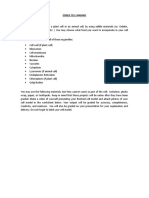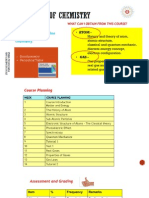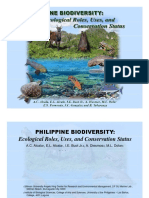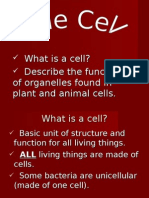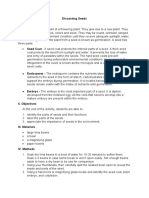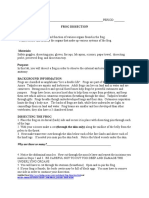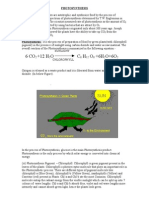Monocot vs. Dicot
Monocot vs. Dicot
Uploaded by
RonalynCopyright:
Available Formats
Monocot vs. Dicot
Monocot vs. Dicot
Uploaded by
RonalynOriginal Description:
Copyright
Available Formats
Share this document
Did you find this document useful?
Is this content inappropriate?
Copyright:
Available Formats
Monocot vs. Dicot
Monocot vs. Dicot
Uploaded by
RonalynCopyright:
Available Formats
A monocot has only one seed leaf (monocot is short for 'monocotyledon'.
A cotyledon is a seed leaf, and 'mono' means one). This seed leaf is usually the same
shape as the adult leaf, long and thin, and the leaf veins nearly always run parallel to
the central midrib. Sometimes, the adult leaves are pinnate, as in many palms, but the
veins are parallel on each leaflet. There are several monocot plant families that are
instantly recognisable. Many food plants are grasses. So crops like wheat, oats, barley
and sweetcorn are all monocots. Palms, Orchids, and most bulbous plants are
monocots.
A dicot has two cotyledons (dicot is short for 'dicotyledon', and 'di' means two). The
seed leaves are usually rounded and fat, because they are the two halves of the seed.
The first true leaves can be many different shapes, from long and thin to rounded or
palmate. Most trees and shrubs and many garden annuals and perennials are dicots,
and there are many more species of dicots than there are monocots.
Monocots have only one seed leaf inside the seed coat. It is often only a thin leaf, because the
endosperm to feed the new plant is not inside the seed leaf. Dicots have two seed leaves
inside the seed coat. They are usually rounded and fat, because they contain the endosperm to
feed the embryo plant.
Monocot seeds include garlic, onion, corn, rice, wheat, asparagus, lilies and orchids. These seeds are
classified as monocots because they only have one cotyledon inside of their seeds
What Are Cotyledons?
If you're going to count the number of cotyledons, it helps to know what they are. These are the first
leaves a flowering plant produces, and they're often called seed leaves because they're part of the seed,
not really party of the mature plant. These leaves give the plant access to the seed's stored nutrients to
nourish it until the plant develops its true leaves. True leaves are those which do the work of
photosynthesis.
More About Dicots
Dicots, or dicotyledonous seeds, have two cotyledons and contain endosperms inside
of their seeds. They produce plants with thick, wide leaves. Examples of dicot seeds
include peppers, cabbage, turnips, tomatoes, apples, carrots, potatoes and celery.
Dicots produce large leaves, which in turn nourish new dicot seeds.
What About Plants Without Cotyledons?
There are plants that don't have cotyledons, placing them squarely outside the
monocot vs. dicot grouping. These are nonflowering plants. Examples include those
that form spores like ferns or those like evergreens that form cones instead of
cotyledons.
You might also like
- Instructions and Guidelines Super-Sheet Is The Worksheet To UseDocument51 pagesInstructions and Guidelines Super-Sheet Is The Worksheet To Useabdul100% (2)
- Earthworm DissectionDocument4 pagesEarthworm DissectionJJ AlmagroNo ratings yet
- M2-L2-Cell Cycle and Cell DivisionDocument2 pagesM2-L2-Cell Cycle and Cell DivisionAira Estandian GutierrezNo ratings yet
- RHS Practical House Plant Book - Choose The Best, Display Creatively, Nurture and Care, 175 Plant Profiles (PDFDrive)Document226 pagesRHS Practical House Plant Book - Choose The Best, Display Creatively, Nurture and Care, 175 Plant Profiles (PDFDrive)carolina vazquez100% (8)
- Scientific Inquiry Lesson: Flower Dissection LabDocument10 pagesScientific Inquiry Lesson: Flower Dissection LabNicole McIntyreNo ratings yet
- BIO 31A Exercise 3Document7 pagesBIO 31A Exercise 3Genevieve GayosoNo ratings yet
- Ateneo de Zamboanga University: Course Outline (Second Semester) ZOO 208Document1 pageAteneo de Zamboanga University: Course Outline (Second Semester) ZOO 208Almira AhamadNo ratings yet
- Ecological Succession ActivityDocument3 pagesEcological Succession Activityapi-236697820100% (1)
- Monocots Vs DicotsDocument3 pagesMonocots Vs Dicotsmonkey luffy100% (1)
- 5e Flower Dissection Investigation - Spring 2016Document3 pages5e Flower Dissection Investigation - Spring 2016api-309653899No ratings yet
- Gumamela Flower DissectionDocument9 pagesGumamela Flower DissectionlheninyamooNo ratings yet
- Edible Cell MakingDocument4 pagesEdible Cell MakingThefani Maezel Lofamia100% (1)
- Principles of Chemistry SPECTRUM Lecture 1Document18 pagesPrinciples of Chemistry SPECTRUM Lecture 1Mei Chin LyeNo ratings yet
- Chromatography LabDocument3 pagesChromatography LabOuissal HichourNo ratings yet
- Monocot and Dicot PlantsDocument4 pagesMonocot and Dicot PlantsFaiza AminNo ratings yet
- Chromatography LabDocument2 pagesChromatography LabAniqah SaifuladliNo ratings yet
- Lec3 Plant Cell and Plant TissueDocument129 pagesLec3 Plant Cell and Plant TissueDANIEL LANCE NEVADONo ratings yet
- Monocots Vs Dicots LabDocument2 pagesMonocots Vs Dicots LabCaselyn ButayNo ratings yet
- Intro To OrganicDocument47 pagesIntro To OrganicAlexandria Baldedara100% (1)
- Plants Reproduction and DevelopmentDocument6 pagesPlants Reproduction and DevelopmentAlwìn GarciaNo ratings yet
- PowerPoint - Anatomy of PlantsDocument72 pagesPowerPoint - Anatomy of PlantsDeoveon Cadoree100% (1)
- Botany Exam PDFDocument9 pagesBotany Exam PDFanon_262141250No ratings yet
- Botany IntroDocument4 pagesBotany IntroMichi OnozaNo ratings yet
- Lewis Structure and Chemical BondingDocument36 pagesLewis Structure and Chemical BondingAlyssa Crizel CalotesNo ratings yet
- General BotanyDocument5 pagesGeneral BotanyKNo ratings yet
- LAB 1 (Onion Cells)Document5 pagesLAB 1 (Onion Cells)Rea FrancineNo ratings yet
- Introduction To SystematicsDocument56 pagesIntroduction To SystematicsVeronica MedranoNo ratings yet
- General BotanyDocument4 pagesGeneral BotanyAngela ParaynoNo ratings yet
- Flower Dissection 2022Document15 pagesFlower Dissection 2022Sydney BiondoNo ratings yet
- Course Outline in Botany 101Document4 pagesCourse Outline in Botany 101Anonymous lKxkZ9MNo ratings yet
- Lab Activity 5: Plant Morphology: StemDocument5 pagesLab Activity 5: Plant Morphology: StemPaul100% (1)
- Lesson 3Document14 pagesLesson 3Kaizen100% (1)
- Act 8 The Leaves - Laboratory ReportDocument8 pagesAct 8 The Leaves - Laboratory ReportAmy BalicagNo ratings yet
- PTERIDOPHYTADocument16 pagesPTERIDOPHYTAshriya shuklaNo ratings yet
- Lab - Flower DissectionDocument10 pagesLab - Flower DissectionFatima RiveraNo ratings yet
- Philippine Biodiversity Ecological RolesDocument60 pagesPhilippine Biodiversity Ecological RolesRonnelMananganCorpuz100% (2)
- Earthworm DissectionDocument5 pagesEarthworm Dissectionunexia.productions101No ratings yet
- Introduction To Botany (W1)Document12 pagesIntroduction To Botany (W1)ASHLEY NICOLE JACINTO100% (1)
- Ach 101 - Organic Chemistry For AgricultureDocument138 pagesAch 101 - Organic Chemistry For AgricultureNana Kwame BoatengNo ratings yet
- Gene InteractionDocument14 pagesGene InteractiondomeniclwandileNo ratings yet
- Plant StructureDocument5 pagesPlant StructurenathanielNo ratings yet
- What Is A Cell? Describe The Functions of OrganellesDocument18 pagesWhat Is A Cell? Describe The Functions of Organellestdukes546No ratings yet
- Cell and Cell TheoryDocument21 pagesCell and Cell TheoryMARY ANN PANGANNo ratings yet
- SystematicsDocument24 pagesSystematicsMARCOS RODSEL CUADRASAL MATEONo ratings yet
- BotanyDocument4 pagesBotanyRejie Canny CariasoNo ratings yet
- Gen Biology Module Lesson 2&3Document13 pagesGen Biology Module Lesson 2&3Albert Jade Pontimayor LegariaNo ratings yet
- LeavesDocument16 pagesLeavesjasta114No ratings yet
- Seeds Laboratory ActivityDocument3 pagesSeeds Laboratory ActivityDaryl Boldios LoterteNo ratings yet
- Tissues: Chapter - 6Document17 pagesTissues: Chapter - 6Aditya Jha100% (1)
- Exercise 6 External Stem StructureDocument3 pagesExercise 6 External Stem StructureKristin Denis Corvera100% (1)
- Villanueva - Bot01 Lab Act #4Document14 pagesVillanueva - Bot01 Lab Act #4Kath ErineNo ratings yet
- Hay InfusionDocument1 pageHay Infusioninnoaruta_22No ratings yet
- Zoology LectureDocument6 pagesZoology LectureMARIA ELIZA LOMUNTADNo ratings yet
- G7 Frog Dissection PDFDocument9 pagesG7 Frog Dissection PDFAbu KaramNo ratings yet
- Activity 7 - Cell Cycle & Cell Division PDFDocument3 pagesActivity 7 - Cell Cycle & Cell Division PDFKiro ZeroNo ratings yet
- 1) Introduction To Organic Chemistry Chem 32 (Up Manila)Document51 pages1) Introduction To Organic Chemistry Chem 32 (Up Manila)Paul AlcosNo ratings yet
- PhotosynthesisDocument4 pagesPhotosynthesisapi-3729258100% (1)
- Plant EmbryogenesisDocument19 pagesPlant EmbryogenesisJosiahBriz-Rull100% (1)
- Performance Task 4 CladogramsDocument5 pagesPerformance Task 4 Cladogramsapi-350791295No ratings yet
- Leaf ChromatographyDocument2 pagesLeaf ChromatographyKamaldeep MaanNo ratings yet
- Leaves Activity SheetDocument6 pagesLeaves Activity SheetTJ ArciagaNo ratings yet
- Basic Botany 2Document92 pagesBasic Botany 2Michael OduorNo ratings yet
- Insta Green British English StudentDocument8 pagesInsta Green British English StudentCarolFernandesNo ratings yet
- Industrial Training at PPCL (Pragati Power Corporation LTD) : Simranjeet Singh 10216210059Document12 pagesIndustrial Training at PPCL (Pragati Power Corporation LTD) : Simranjeet Singh 10216210059Simmy SinghNo ratings yet
- Syllabus Class 11Document154 pagesSyllabus Class 11arundhatiNo ratings yet
- SR Elite, Aiims S60, Neet MPL & Ic - LTC Neet Grand Test - 4 Paper (24-04-18) PDFDocument32 pagesSR Elite, Aiims S60, Neet MPL & Ic - LTC Neet Grand Test - 4 Paper (24-04-18) PDFGanesa Sri Vel100% (1)
- 2021-P6-Science-Semestral Assessment 1-NanyangDocument42 pages2021-P6-Science-Semestral Assessment 1-Nanyangအင္တာေနရွင္နယ္ေက်ာင္းမ်ား၏ ေမးခြန္လႊာဘာသာစံုျဖန္႕ခ်ီေရးNo ratings yet
- Jaguar Land Rover Limited 2018Document83 pagesJaguar Land Rover Limited 2018Priya NaveenNo ratings yet
- 0610 s06 QP 6Document12 pages0610 s06 QP 6Hubbak Khan100% (1)
- Writter Activity 1Document2 pagesWritter Activity 1PriYaGordoraNo ratings yet
- Combretum Leprosum Usada para AsmaDocument26 pagesCombretum Leprosum Usada para AsmamarcosmenesesprNo ratings yet
- Identification OF Common Weed Found IN SAU FarmDocument10 pagesIdentification OF Common Weed Found IN SAU FarmRoshan KumarNo ratings yet
- Form 4 Biology - Paper 2 - Question PaperDocument11 pagesForm 4 Biology - Paper 2 - Question PaperraymurigiNo ratings yet
- The Northwest School For Botanical Studies Herbal Tea RecipesDocument6 pagesThe Northwest School For Botanical Studies Herbal Tea RecipesNiko DiamesisNo ratings yet
- Biblioprof TabDocument585 pagesBiblioprof Tabjegarciap0% (1)
- G7 Science - Quarter 2 RemedialDocument1 pageG7 Science - Quarter 2 RemedialPeejay EmraduraNo ratings yet
- Her Book - Poems by Éireann LorsungDocument18 pagesHer Book - Poems by Éireann LorsungMilkweed EditionsNo ratings yet
- Butterfly Sight WordsDocument10 pagesButterfly Sight Wordswassy121No ratings yet
- φ= a+b a a bDocument3 pagesφ= a+b a a bJohn Luis BantolinoNo ratings yet
- Grandpa Farouks Garden CC Picture Book PDFDocument14 pagesGrandpa Farouks Garden CC Picture Book PDFDeepak RawatNo ratings yet
- VLAVEDAT - The Vegetation Database of Flanders (Northern Belgium)Document8 pagesVLAVEDAT - The Vegetation Database of Flanders (Northern Belgium)Djamel AnteurNo ratings yet
- Solved SSC CHSL 4 July 2019 Shift-1 Paper With SolutionsDocument36 pagesSolved SSC CHSL 4 July 2019 Shift-1 Paper With SolutionsVIKAS GAUTAMNo ratings yet
- Adcoamul Eligiblelist 1249 190124Document4 pagesAdcoamul Eligiblelist 1249 190124monishanew105No ratings yet
- Feed AdditivesDocument15 pagesFeed AdditivescsandrasNo ratings yet
- Prospects of Protected Cultivation TechnologiesDocument6 pagesProspects of Protected Cultivation TechnologiesKuldeep DekaNo ratings yet
- KamiasDocument7 pagesKamiasClerSaintsNo ratings yet
- Gerbera - WikipediaDocument19 pagesGerbera - WikipediaSukhdev KumarNo ratings yet
- Kirundi - English DictionaryDocument170 pagesKirundi - English DictionaryBrig50% (2)
- Cognosy Volatile OilsDocument15 pagesCognosy Volatile OilsHerani WorkuNo ratings yet
- Gen Bio Week 3 ActivityDocument3 pagesGen Bio Week 3 ActivityJasper BarlisNo ratings yet











